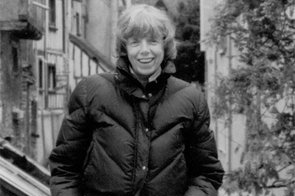Jill Johnston, author of “Lesbian Nation,” died from complications of a stroke Sept. 18. Her death was announced Sept. 22 by her wife, Ingrid Nyeboe. Johnston was 81.
For a whole generation, Johnston was the first out lesbian writing for a newspaper — New York City’s Village Voice — that was neither queer nor underground. She was a cultural critic, an advocate of lesbian separatism and she brought one of the major literary sexists, Norman Mailer, to his knees in public.
Johnston was an iconoclast even among iconoclasts. She was out before Stonewall. She was writing about being a lesbian before it was popular. She was making out in public at literary forums. She was advocating that women leave their husbands (as she had) and insisting that all women were lesbians; some just had not yet discovered it.
She stirred up anger and resentment, adoration and fealty in the burgeoning second wave of feminism, making everyone in the feminist hierarchy either acutely uncomfortable or secretly thrilled by her antics.
Johnston began writing for the Village Voice in 1959, at age 30, and had a column there for 15 years. She began as a dance critic, but in the halcyon days of 1960s New York City, was encouraged to take on cultural issues as a beat. Her columns, written in all lower-case letters and with only sporadic punctuation, had the look, feel and sound of something urgent, something brewing, something about to erupt. Johnston’s writings were inherently 1960s-style revolutionary text and, for the uninitiated, definitively subversive.
Like many young lesbians, I discovered Johnston while I was in high school. Johnston’s writing was public and yet many considered it dangerous. Clippings of her writings — including her infamous “coming out” column titled “Lois Lane Is a Lesbian” — found in my high-school locker were part of the materials used to expel me from Philadelphia High School for Girls for being a lesbian.
But discovering Johnston was a lifeline for many of us. Her writing was a portal to the new age of open queerness. In the early 1970s, she was hitting her zenith as both writer and activist. Her openness about her sexuality and her love for women was breathtaking, groundbreaking stuff in the early 1970s — and just as highly controversial. She had a confrontational, in-your-face activist style of writing and public speaking that pre-dated groups like ACT-UP and Queer Nation by decades.
The now-notorious literary panel at New York’s Town Hall in 1971 was one of the most scandalous events of the entire feminist movement. A group of feminist lions — the critic Diana Trilling, NY NOW president Jacqueline Ceballos, feminist writer Germaine Greer and Johnston — took on Norman Mailer and his recently released anti-feminist tome, “The Prisoner of Sex.”
It started out tame and then became a free-for-all, thanks to Johnston, who had a lover jump onto the stage and begin kissing her. A third woman then joined them and Johnston mimicked sex on the floor of the stage with her, flummoxing Mailer who demanded, “Come on, Jill, be a lady.”
Mailer was trounced by Johnston’s activist approach. She later wrote about it in the Voice.
When Johnston’s book “Lesbian Nation: The Feminist Solution” was published in 1973, her theories sparked a national lesbian-separatist movement. Women-only communities sprang up around the country with Johnston as their progenitor.
In “Lesbian Nation,” Johnston wrote: “Many feminists are now stranded between their personal needs and their political persuasions. The lesbian is the woman who unites the personal and political in the struggle to free ourselves from the oppressive institution [of marriage] … By this definition lesbians are in the vanguard of the resistance.”
It was heady stuff in those days, when marriage to a man was the goal for all women — so much so that Johnston’s approach to lesbian feminism caused a schism within the lesbian and feminist communities. Some lesbians insisted on referring to themselves as “gay” to differentiate themselves from the women who followed Johnston.
Johnston spent her later years writing about art, dance and literature. And while her wife asserts that this was the writing of which she was most proud, for many lesbian feminists of the 1960s, ’70s and ’80s, Johnston’s manifesto on lesbian separatism was the foundation for all subsequent feminist theory. Johnston redefined how lesbians looked at their lives — not in relationship to men, but in relationship to each other. She was a pivotal, provocative figure in queer liberation — and as such, an historic icon of the movement for queer civil rights as well as the rights of women.
She is survived by Nyeboe; her children from her marriage to Richard Lanham: Richard and Winifred; four grandchildren and two great-grandchildren. Johnston married Nyeboe in 1993 in Denmark after having lived with her since 1980; the couple, who lived in Hartford, Conn., married there in 2009.

